Three tunnels along an abandoned road on Shibaluohanshan (Eighteen Arhats Mountain, 十八羅漢山) in Kaohsiung that was once a key route for the camphor oil trade are now popular tourist attractions, and are expected to draw a lot of visitors over the Lunar New Year holiday.
One of the Liouguei Tunnels (六龜隧道) in Liouguei District (六龜) is inhabited by hundreds of Taiwanese leaf-nosed bats, while another is home to a large number of Pacific swallows, all of whom took up residence in the tunnels after 1992, when the road through them that was built in 1936 was replaced by one that bypasses the mountain.
Liouguei District is between the Pingtung Plain and the Central Mountain Range, and its forests, at 800m above sea level, were perfect for camphor trees, said local tour guide Chang Yun-cheng (張運正), whose family has lived in the area for several generations.
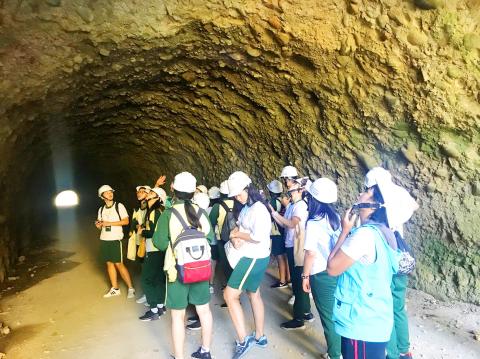
Photo: CNA
During the Japanese colonial era from 1895 to 1945, Liouguei was known for its output of camphor oil, which was a key ingredient in insect repellents as well as smokeless powder used in the production of bullets and artillery shells, Chang said.
The lucrativeness of the camphor trade led the Japanese colonial government to construct a route through Shibaluohanshan in the 1930s to facilitate the transport of camphor and logs.
The Japanese drilled six tunnels with a total length of 792m along the route, Chang said.
However, the importance of the tunnels as an economic and strategic lifeline gradually faded after Japan withdrew from Taiwan in 1945.
However, the increase in traffic in the 1980s, with a heavy volume of vehicles carrying visitors to Shibaluohanshan and other forested sites in Liouguei and neighboring Meinong District (美濃) led to the construction of Taiwan Provincial Highway 27A, which opened in 1992. At the same time, Shibaluohanshan was designated as part of a nature reserve, which left the tunnels to wildlife.
The Forestry Bureau reopened three of the tunnels to visitors in September last year, and hired guides to provide tours of their ecological and cultural features.
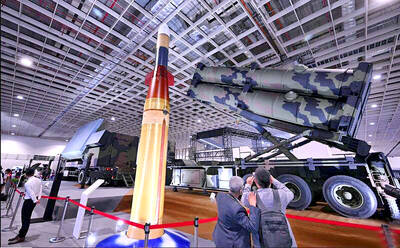
Taiwan is to commence mass production of the Tien Kung (天弓, “Sky Bow”) III, IV and V missiles by the second quarter of this year if the legislature approves the government’s NT$1.25 trillion (US$39.78 billion) special defense budget, an official said yesterday. Commenting on condition of anonymity, a defense official with knowledge of the matter said that the advanced systems are expected to provide crucial capabilities against ballistic and cruise missiles for the proposed “T-Dome,” an advanced, multi-layered air defense network. The Tien Kung III is an air defense missile with a maximum interception altitude of 35km. The Tien Kung IV and V
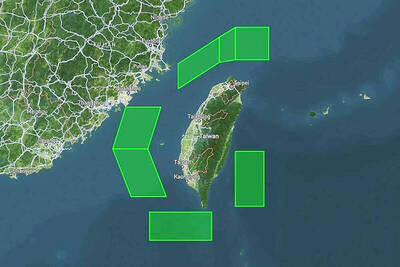
The disruption of 941 flights in and out of Taiwan due to China’s large-scale military exercises was no accident, but rather the result of a “quasi-blockade” used to simulate creating the air and sea routes needed for an amphibious landing, a military expert said. The disruptions occurred on Tuesday and lasted about 10 hours as China conducted live-fire drills in the Taiwan Strait. The Civil Aviation Administration (CAA) said the exercises affected 857 international flights and 84 domestic flights, affecting more than 100,000 travelers. Su Tzu-yun (蘇紫雲), a research fellow at the government-sponsored Institute for National Defense and Security Research, said the air
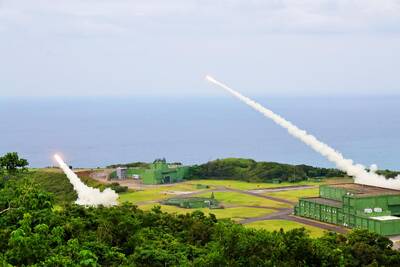
Taiwan lacks effective and cost-efficient armaments to intercept rockets, making the planned “T-Dome” interception system necessary, two experts said on Tuesday. The concerns were raised after China’s military fired two waves of rockets during live-fire drills around Taiwan on Tuesday, part of two-day exercises code-named “Justice Mission 2025.” The first wave involved 17 rockets launched at 9am from Pingtan in China’s Fujian Province, according to Lieutenant General Hsieh Jih-sheng (謝日升) of the Office of the Deputy Chief of the General Staff for Intelligence at the Ministry of National Defense. Those rockets landed 70 nautical miles (129.6km) northeast of Keelung without flying over Taiwan,
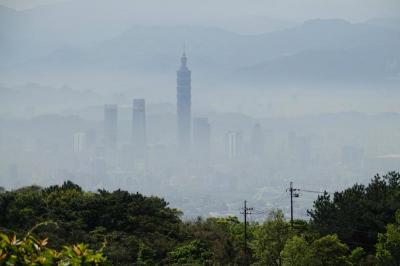
A strong continental cold air mass is to bring pollutants to Taiwan from tomorrow, the Ministry of Environment said today, as it issued an “orange” air quality alert for most of the country. All of Taiwan except for Hualien and Taitung counties is to be under an “orange” air quality alert tomorrow, indicating air quality that is unhealthy for sensitive groups. In China, areas from Shandong to Shanghai have been enveloped in haze since Saturday, the ministry said in a news release. Yesterday, hourly concentrations of PM2.5 in these areas ranged from 65 to 160 micrograms per cubic meter (mg/m³), and pollutants were